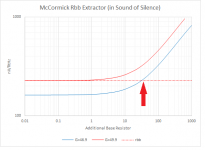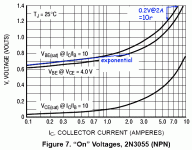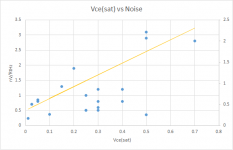I hope some guru's can spread some light on the topic. Least as I can determine there are at several ways which the DIY-amateur can measure base spreading resistance of a BJT:
One of the articles I picked up (1) uses the input impedance of a BJT as common emitter amplifier. "The intersection of the curve (modulus of impedance) with the frequency axis in the increasing direction gives the value of the base resistance."
Re{Zi} = rbb' + hfe0 * re/(1+ f/fhfe)
Re-arrange the terms and rb falls out.
I am wondering if someone can shed some light on another method which uses characteristics of the parasitic pnp transistor in an NPN transistor via the Gummel plot. I don't have an HP4155 and don't want to buy one (2).
1. Toker, "A novel measurement method for extraction of the base resistance in the BJT", Microelectronics Journal 30(1999), 41-44
2. Zimmer, Berkner et al, "Method for Determining the Effective Base Resistance of Bipolar Transistors", IEEE BCTM7.3
One of the articles I picked up (1) uses the input impedance of a BJT as common emitter amplifier. "The intersection of the curve (modulus of impedance) with the frequency axis in the increasing direction gives the value of the base resistance."
Re{Zi} = rbb' + hfe0 * re/(1+ f/fhfe)
Re-arrange the terms and rb falls out.
I am wondering if someone can shed some light on another method which uses characteristics of the parasitic pnp transistor in an NPN transistor via the Gummel plot. I don't have an HP4155 and don't want to buy one (2).
1. Toker, "A novel measurement method for extraction of the base resistance in the BJT", Microelectronics Journal 30(1999), 41-44
2. Zimmer, Berkner et al, "Method for Determining the Effective Base Resistance of Bipolar Transistors", IEEE BCTM7.3
Last edited:
Some links:
http://www.joerg-berkner.de/Fachartikel/pdf/1996_BCTM_Zimmer_Method_for_Determining_RB.pdf
A novel measurement method for extraction of the base resistance in the BJT - PDF Free Download
Using LF Noise to determine Re and Rb http://citeseerx.ist.psu.edu/viewdoc/download?doi=10.1.1.29.8041&rep=rep1&type=pdf
http://www.joerg-berkner.de/Fachartikel/pdf/1996_BCTM_Zimmer_Method_for_Determining_RB.pdf
A novel measurement method for extraction of the base resistance in the BJT - PDF Free Download
Using LF Noise to determine Re and Rb http://citeseerx.ist.psu.edu/viewdoc/download?doi=10.1.1.29.8041&rep=rep1&type=pdf
Elvee is one of the most creative guys for analog T&E, I most assuredly respect his creativity, but in this case, his design makes my eyes bleed.
I don't know how well the suggestion of comparing noise to Rb will work, but will try it. Ceteris paribus, placing a resistor in series with the base connection will change the input impedance and noise, will not change Re, and you should thus be able to derive Rbb.
Last edited:
Thanks, but in this case, it was a failure anyway: the instrument manages to measure the Rbb (any additional resistance placed in series with the base is accurately measured), but the measurement is also corrupted by an unknown parameter/effect that I was unable to identify.Elvee is one of the most creative guys for analog T&E, I most assuredly respect his creativity, but in this case, his design makes my eyes bleed.
It works perfectly in sim though, meaning it has to be some sort of subtle, higher-order effect, not taken into account by the regular spice transistors parameters.
This is unfortunate, because it makes the investigations so much more complicated: it is impossible to single out a parameter of a physical transistor and tweak it to see its effect on the result.
Thus, for the moment the tester remains on the back-burner, but I am afraid it will stay there for ever
The technique is well-proven and does work, I have made a test-jig for it.I don't know how well the suggestion of comparing noise to Rb will work, but will try it. Ceteris paribus, placing a resistor in series with the base connection will change the input impedance and noise, will not change Re, and you should thus be able to derive Rbb.
However, if a high resolution is required, it is necessary to include a high pass filter before the level measurement, because in low-Rbb transistors, excess noise is so hugely dominant that it completely drowns the Johnson noise.
TAOE 3rd edition contains measured values of Rbb and circuit schematics of test fixtures used in the measurements, Fig 8.92.
Here is a diyAudio post by one of the authors of the book, discussing the measurement process.
Here is a diyAudio post by one of the authors of the book, discussing the measurement process.
Vogel gives the example of "McCormick's RBB Extractor" in "The Sound of Silence" -- I used a 2N4403 @1mA to create a chart of noise with different inserted base resistors. The model in LTSpice has rb=10R. The McCormick method seems to yield rb of approximately 30R.
Good thing I had the kindle here -- my hard-copy AoE is 450 miles away in NJ
Good thing I had the kindle here -- my hard-copy AoE is 450 miles away in NJ
Attachments
Quick-thought, not explored:
Measure the B-E junction, as a diode, at high current. (Possibly risking the device, but most are cheap.) Plot on lin-log paper. It will be essentially exponential (straight on lin-log) to a point, and then become linear (rising as a curve).
Measure the B-E junction, as a diode, at high current. (Possibly risking the device, but most are cheap.) Plot on lin-log paper. It will be essentially exponential (straight on lin-log) to a point, and then become linear (rising as a curve).
Attachments
Since Z[in] = re + rb and re is a function of collector current, there's the issue. At 1mA it's 25 ohms.
...there's the issue.
Where??
...At 1mA it's 25 ohms.
I'm well aware of re. It dominates the part until HIGH current. I'm proposing far more than a mere 1mA, so that re drops (to 0.25r at the left side of my plot) and the near-resistance dominates over the dynamic impedance.
Buy a ZTX851 (NPN transistor) for $1.13, from DigiKey. Measure its Rbb using your proposed method. See if you can confirm or refute the measured value in Horowitz and Hill's book The Art Of Electronics, 3rd edition, which says that Rbb for a ZTX851 is 1.67 ohms.
There is another transistor with an even lower Rbb in TAOE_ed3. Look at the bottom most entry in Table 8.1(a). Wow.
There is another transistor with an even lower Rbb in TAOE_ed3. Look at the bottom most entry in Table 8.1(a). Wow.
Where??
I'm well aware of re. It dominates the part until HIGH current. I'm proposing far more than a mere 1mA, so that re drops (to 0.25r at the left side of my plot) and the near-resistance dominates over the dynamic impedance.
At higher current you begin heating the part and Vt changes accordingly. But 10mA might work! Will try it on the bench.
Mark - i have a bagful of 951/851!
Last edited:
You are going to measure the parameter called RBM in spice-talk, but that is a very minor part of the problem: what you want to know is the Rbb under actual operating conditions of Vce and Ic, and it will normally be very different from RBM, because it is an extreme.
In spice, other modulating factors intervene, like RB and IRB, but even the full set only gives a very simplified idea of the reality; plus, most of the time, these parameters are absent or defaulted in many models.
The interesting part of RBB is the modulated one, and to extract it, you have to remove Re, obviously, and the elusive Rbb appears as a deviation from the regular dynamic resistance 26/Ib inherent to the BE junction.
Not an easy task, because the extraction has to take place exactly at the target working conditions.
In addition, various non-ideality factors complicate the tasks
In spice, other modulating factors intervene, like RB and IRB, but even the full set only gives a very simplified idea of the reality; plus, most of the time, these parameters are absent or defaulted in many models.
The interesting part of RBB is the modulated one, and to extract it, you have to remove Re, obviously, and the elusive Rbb appears as a deviation from the regular dynamic resistance 26/Ib inherent to the BE junction.
Not an easy task, because the extraction has to take place exactly at the target working conditions.
In addition, various non-ideality factors complicate the tasks
You are going to measure the parameter called RBM in spice-talk, but that is a very minor part of the problem
and it gets "hairier" with temperature.
i think that the authors of TAoE3 backed into base resistance from the noise measurement via the apparatus shown in figure 8.92
I recommend you consider Elvee's recommendations very thoughtfully; he worked extremely hard to (unsuccessfully) measure the base spreading resistance, using his Black Knight test fixture.
I just started to look into low noise BJT transistors. I am curious if there is any pattern of which transistors would be good. In general one needs high hfe and low rbb. But since Rbb is not usually given, I looked for transistors with low Vce(sat) and low Rce. Known low-noise transistors, such as ZTX851 are typically of this kind, medium-power switching transistors with low Vce.
I came across some relatively new transistors from Nexperia, along the lines of PBSS4021NZ. They have higher hfe and lower Vce than ZTX851 and similar. Am I on the right path? Has anyone tried one of these?
I came across some relatively new transistors from Nexperia, along the lines of PBSS4021NZ. They have higher hfe and lower Vce than ZTX851 and similar. Am I on the right path? Has anyone tried one of these?
Parameter extraction is a difficult process when you get down to the details. As DIY I would not go further than extracting Re from the log conformance and rbb from noise vs Ic. You can use he device to amplify its own noise so getting an answer good enough for say a MC pre-amp is pretty straight forward.
Max, you are on the right path with low Vcesat there are good physical reasons that low parasitic resistances go hand in hand with it. I doubt there are any truly ultra-low noise bi-polars with 200mV Vcesat's
Max, you are on the right path with low Vcesat there are good physical reasons that low parasitic resistances go hand in hand with it. I doubt there are any truly ultra-low noise bi-polars with 200mV Vcesat's
Last edited:
Max, you are on the right path with low Vcesat there are good physical reasons that low parasitic resistances go hand in hand with it. I doubt there are any truly ultra-low noise bi-polars with 200mV Vcesat's
I took the data for Vcesat from datasheets and noise from TAoEV3 Table 8.1a:
Attachments
Geez! It's not possible to draw a horizontal line across that graph and say: any transistor with a noise less than THIS HORIZONTAL LINE, also has a very low Vcesat.
It's also not possible to draw a vertical line across that graph and say: any transistor with a Vcesat less than THIS VERTICAL LINE, also has very low noise.
A darn shame, either of those would have been a super handy rule of thumb.
It's also not possible to draw a vertical line across that graph and say: any transistor with a Vcesat less than THIS VERTICAL LINE, also has very low noise.
A darn shame, either of those would have been a super handy rule of thumb.
Should have mentioned that there are 3 MAT/SSM devices from ADI which have very low Vcesat but noise stats which may be overly conservative. I used the 1kHz data where I could find it. Many of these ADI devices are EOL.
- Status
- Not open for further replies.
- Home
- Design & Build
- Equipment & Tools
- Measuring base spreading resistance


